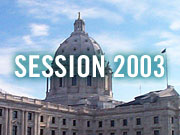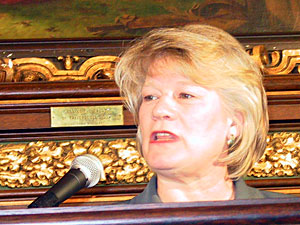Photos
Your Voice
| |||||||||||||||||||||||||||||||||||||||||||||
Pawlenty releases highway plan
March 14, 2003
Gov. Tim Pawlenty has released a five-year transportation package that he says will jumpstart road and bridge projects across the state. The plan relies on borrowing $550 million for highway construction and seeks an equal amount in advance funds from the federal government. Critics say the plan is shortsighted and makes almost no allowances for public transit.
St. Paul, Minn. — Gov. Pawlenty is advertising his initiative as a way to infuse much-needed cash into the state's roads and bridges. His plan to borrow $550 million is in keeping with campaign promises to offer a "mega bonding bill," although the price tag is significantly smaller. Still, Pawlenty says given the state's fiscal woes, the plan strikes the right balance. And he says borrowing now and paying later will save tax dollars.
"The cost of road construction, depending on the corridor, is accelerating way beyond the rate of inflation. And so by accelerating these projects from 10 years out or 15 years out to four years out or five years out, in the real cost of the project, we are saving substantial sums of money. And that's one appeal," Pawlenty said.
 | |||
On top of the borrowed money, the plan would take advantage of new rules to access federal tranportation dollars ahead of schedule. Pawlenty says that will bring total new spending to more than $1 billion over five years.
Fred Corrigan, the executive vice president of the Minnesota Transportation Alliance, says to meet transportation demands the state would have to spend a $1 billion each year for the next 10 years. But he says he's encouraged to see Pawlenty take a first step.
"Given what we saw around here in the '90s where we made no progress at all, I think, again, seeing a governor take even a modest step in that direction is something that I believe the Legislature will now have the opportunity to build on," according to Corrigan.
To repay the borrowed cash, Pawlenty has proposed trimming administrative and overhead costs at the state Transportation Department. Pawlenty says since MnDOT is largely funded by dedicated highway revenues, it has largely been spared from recent budget pressures, leaving some room for squeezing out extra funds.
But Senate Transportation Finance Chair Dean Johnson says that raises some concerns. The Willmar DFLer says Pawlenty's plan for building new roads could come at the cost of public safety on the state's existing highways. "by not striping our highways -- restriping -- shutting down dozens of our rest stops, turning off lights at some of the intersections and not -- and laying off some of our maintenance people who are fixing the potholes and snowplows," he said.
Lt. Gov. Carol Molnau, who also heads MnDOT, says Johnson's concerns are misplaced. She says most of the cuts will come from administration. She notes that many rest stops have outlived their usefulness as development sprung up around them. And she says new technologies allow lane-dividing pavement stripes to be repainted less frequently.
"Do we have better substances to use than we had in the past and can we do it less often because they last longer? The answer to that is yes," she said.
|
There won't be any buses or any bus drivers to actually use those transit advantages. So they're really meaningless.
- Transit for Livable Communities Director Lea Schuster |
Johnson, however, says he has other concerns. He says the governor's plan is a fundamental shift away from the traditional pay-as-you-go approach to road construction. Johnson says borrowing against future state and federal dollars will leave a hole in later budgets. He says he'd prefer a permanent stream of new revenue, such as an increase in the gas tax, but Pawlenty has categorically ruled that out.
Transit advocates also say their concerns have been overlooked. Pawlenty does offer some roadway and capital improvements -- such as park-and-ride lots or enhanced shoulder lanes -- that buses could take advantage of.
Transit for Livable Communities Director Lea Schuster calls the plan "smoke and mirrors."
"It's building more roads and saying, 'Oh, yeah, you can use the shoulders for transit.' But the problem is with the kind of cuts that he's made to the transit services in other parts of his budget, there won't be any buses or any bus drivers to actually use those transit advantages. So they're really meaningless," Schuster said.
Schuster notes that Pawlenty's general fund budget, which covers everything from education to health care to public safety, actually cuts service for Metropolitan Transit. But Pawlenty says the funding sources he's outlined for his transportation package are constitutionally dedicated to roads and bridges, making it impossible for him to fund transit directly.
|
News Headlines
|
Related Subjects
|


